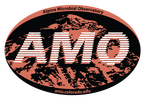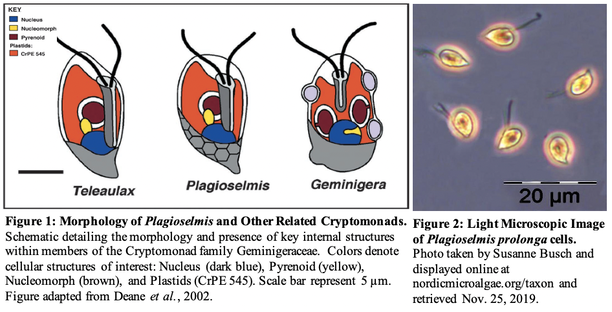|
by Eli Gendron The Cryptophyta are a group of taxonomically ambiguous dinoflagellates, which often exhibit a mixotrophic metabolism, meaning that they are often both a heterotroph (can consume organic or inorganic material for energy) and a photoautotroph (can get all their energy from light using a plastid; Figure 1; Deane et al., 2002). There is evidence that the plastid originated from the engulfment of algal cells in the phylum’s ancestry leaving behind a nucleomorph containing the ancient alga’s DNA (Figure 1; Deane et al., 2002). Cryptophytes are found in aquatic habitats around the world with the most noted freshwater family being the Geminigeraceae, with Plagioselmis being of particular interest for their potential as ecological indicators (Figure 1, 2; Markina et al., 2008). Plagioselmis species such as prolonga can be identified by their distinctive teardrop shape and twin flagella oriented on one pole of the cell (Figure 2; Olenina, 2006). Plagioselmis prolonga has been shown to respond strongly to low flow rates and increased concentrations of key nutrients such as phosphorus and nitrogen (Šupraha et al., 2014). However, Plagioselmis prolonga also is high temperature sensitive and shows a sharp decline in abundance at temperatures greater than 5oC, regardless of nutrient availability (Elliott et al., 2012). Furthermore, Plagioselmis prolonga has also shown to be sensitive to household detergents and other common detergent pollutants commonly found in freshwater and marine ecosystems (Aizdaicher et al., 2006). The sensitivity of Plagioselmis prolonga to multiple measurable environmental variables known to correlate with water quality means that including it in ecological monitoring will likely benefit future research (Markina et al., 2008). Aizdaicher, N. A., & Markina, Z. V. (2006). Toxic effects of detergents on the alga Plagioselmis prolonga (Cryptophyta). Russian Journal of Marine Biology, 32(1), 45-49.
Deane, J. A., Strachan, I. M., Saunders, G. W., Hill, D. R., & McFadden, G. I. (2002). CRYPTOMONAD EVOLUTION: NUCLEAR 18S rDNA PHYLOGENY VERSUS CELL MORPHOLOGY AND PIGMENTATION 1. Journal of Phycology, 38(6), 1236-1244. Elliott, J. A., Jones, I. D., & Thackeray, S. J. (2006). Testing the sensitivity of phytoplankton communities to changes in water temperature and nutrient load, in a temperate lake. Hydrobiologia, 559(1), 401-411. Markina, Z. V. (2008). Application of the microalga Plagioselmis prolonga for the assessment of water quality in the Amursky and Nakhodka Bays (Sea of Japan). Russian journal of marine biology, 34(1), 38-44. Olenina, I. (2006). Biovolumes and size-classes of phytoplankton in the Baltic Sea. Šupraha, L., Bosak, S., Ljubešić, Z., Mihanović, H., Olujić, G., Mikac, I., & Viličić, D. (2014). Cryptophyte bloom in a Mediterranean estuary: High abundance of Plagioselmis cf. prolonga in the Krka River estuary (eastern Adriatic Sea). Scientia marina, 78(3), 329-338.
0 Comments
|
AuthorVarious lab members contribute to the MoM Blog Archives
October 2023
Categories |


 RSS Feed
RSS Feed
